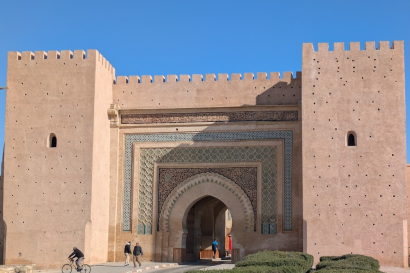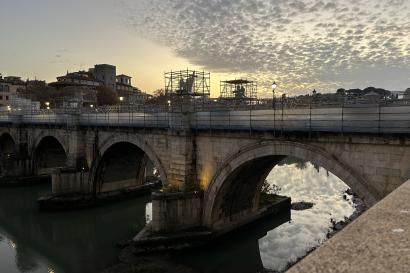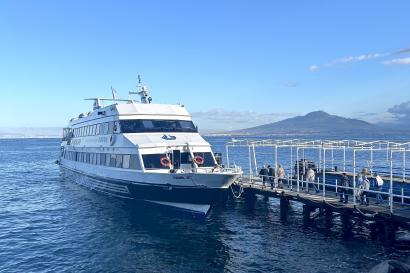Aaaaand we’re in Senegal. This post is way overdue and there is a lot to say. However, I’m going to have to leave you with fragments.
June 7, 2015
Woke up in Senegal this morning. In a white walled, orange accented, hella posh hotel room. And then we went swimming in the rooftop pool. Welcome to Africa.
My luggage got left behind; I am wearing other people’s clothes. It is nice to travel with other people – see previous sentence. It is also strange. I am rifted as we walk, get out of the tour van and meander monuments, half-closed markets, engage or avoid beaded-bracelet sellers, as we comment on this new place.
We all get along very well. The newness has not yet worn off. US-American references (some of which I actually get) become a basis for bonding. I can feel us reaching for them, become safety lines in our displacement.
But when there is a moment of calm, when the laughter and the banter subsides–– when I am left with my own head, my own body in these new places – that is when I am torn. In the front seats of the van: the Senegalese director of the IES program, the tour guide, the driver. (No, I do not know their names). M. and N. and Mr. A., the director of the Rabat chapter, also tourists, but of a different kind. Conversation in the front seats is in French, and Moroccan Darija. And then the back rows: the cacophony of English, us – eight of us American kids, white and whiter, and H., who is half Chinese, and me, with my Manileño grandparents and fast-darkening brown skin. How are we seen, how do we see? Color: a shorthand, perhaps, for something more complicated. Nonetheless, not irrelevant.
Welcome to Africa. I was pleased to find that the phrase does not feel right on a visceral level, that when the others reference our location in “Africa” it feels as if we are in Manila and someone says “Asia.” Yes, okay, but it is the right here that I feel first. The specificity. We are in Manila, Philippines. We are in Dakar, Senegal.
Now that we are here, that truly means something. It is only the first day. I’m excited to find out more exactly what.
***
[Everybody’s got their tea]
[Dakar. Le monument de la renaissance africain]
[Dakar. Couple ascending]
[Dakar.]
[Dakar, underpass]

[Some modern design in the (incredible) archives of the university Cheikh Anta Diop de Dakar]

[A photo from an exhibit on traditional styles of hair]

[My notes from the university’s Musee Theodore Monod d’art africain]
[Melancholy Gorée]
[Specialized high school for high achieving girls, selected from throughout the nation. Named after Mariama Bâ, a well-known Senegalese woman writer]
* * *
June 7, 2015
We’ve been in Dakar a day, barely that. We’ve seen little. And yet, something has changed.
Today we took a short and mostly-driven tour of the city. As we drove by the Place de l’indépendence, I glimpsed the low white walls and realized I recognized it: I had seen it in the film La noire de…, by the Senegalese writer/director Ousmane Sembène, which, not knowing I would be in Senegal some months later, I had watched for French class earlier this year.
When I watched it, it was homework. I was in a hotel room somewhere in Connecticut (long story) and made two available friends watch it with me. I had no context for it. It was the sixties, it was in black and white. It was set in some other place. In retrospect, I realize it was also some Other place – unfamiliar, disorienting, even, for more reasons than simple distance.
But here’s the thing: as soon as I saw that glimpse of white stone walls, things fell into place. Suddenly, thinking back, all those scenes in Senegal seemed perfectly natural. They were in Senegal. Where else would they be? We’ve been here a day, and already that has a different meaning for me. So much of that Otherness dispersed simply by being here. We saw a few places, talked in passing to a few people, sat under this sky. Enough to dispel so much I had not even realized was there.
And suddenly, too, when I put the two together, there were stories. The plaza was not just a place; feet like Diouana’s had walked on those walls. Hopes and dreams and daily banter had floated over what was currently an abandoned expanse. The power of representing a place: expanding what is imagined as possible, there, what it is allowed to be.

[Still from La noire de.../my photo of the place de l’indépendence]
À la prochaine (post specifically dealing with Gorée to come),
-Luna




Luna Beller-Tadiar
<p>Luna Beller-Tadiar is a rising Sophomore at Yale University with strong interests in critical race, class, gender and sexuality studies, subaltern forms of life, art, and language. She loves all forms of the arts (including the martial ones!), and is constantly sketching in restaurants and dancing along city streets. She believes in understanding everything intersectionally, and is excited for the classes she will be taking on Moroccan history and literature to inform her experience and observations both written and sketched of Rabat!</p>







